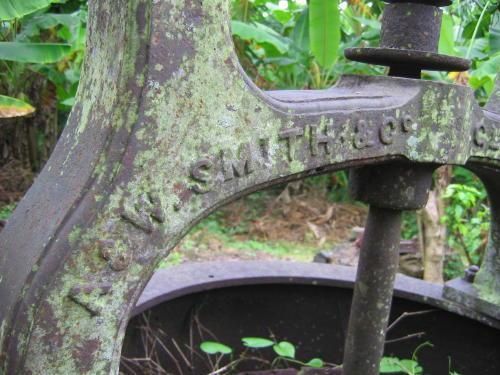Les turbines hydro-extractrices du site de MIRERENI sont originaires de GLASGOW et fabriquées par A et W SMITH.
Vous trouverez sous les photographies un petit résumé en anglais présentant cette Entreprise suivi d'une archive de l'université de Glasgow vantant les mérites de cette entreprise


In 1837, the brothers Andrew and William Smith, millwrights, entered into a partnership as agricultural and general engineers in Paisley, Renfrewshire, Scotland, under the name A & W Smith & Co, millwrights and machine engineers. Their first machine was a 16 inch x 30 inch steam-driven sugar mill for Tobago, West Indies. In 1855, the firm moved to the Eglinton Engine Works in Tradeston, Glasgow, Scotland, and began to specialise in the manufacture of sugar machinery, having been introduced to the sugar industry by W & A McOnie, engineers, Glasgow, who had subcontracted to them the manufacture of cattle-driven sugar mills.
In 1896, they became a limited company, A & W Smith & Co Ltd, and the first chairman was John Wilson, MP. As well as producing sugar machinery, the firm also produced bridge and structural steelwork for locomotive sheds and buildings. Railway wagons and weighbridges were also a speciality and in 1869 the company produced its first tank locomotive for Robson Maynard & Co, coalmasters, Middlesborough, England.
In the twentieth century, the inter-war period saw the sugar machine industry struggle in the general depression of the world economy. Most of the sugar-producing areas were equipped with relatively new machinery with a long life expectancy so the stable demand for sugar meant little work for machinery builders.
![]()
![]()
Most of the West of Scotland firms survived, but only through diversification. A & W Smith & Co Ltd, for example, bought the power hammer business of R G Ross & Sons Ltd in the early 1930s, made Loudon planes for Russia, and took out a licence for sandslingers for foundry use. In 1953, the company was acquired by Tate & Lyle Ltd, sugar refiners, London, England.
The 1950s and 1960s saw a collapse in the industry with A & W Smith & Co Ltd acquiring the goodwill of most of its former rivals. In 1967 they acquired The Mirrlees Watson Co Ltd, and subsequently traded as Smith Mirrlees. Smith Mirrlees was acquired in 1988 by Fletcher & Stewart Ltd, sugar machine manufacturers, Derby, England. They ceased to operate at the Eglinton Works in the late 1980s. In 2002, A & W Smith & Co Ltd was a non-trading subsidiary company of United Molasses, itself a subsidiary of Tate & Lyle plc. The company was the last sugar machinery manufacturers in Scotland.
Source:
Michael Moss and John Hume, Workshop of the British Empire: Engineering and Shipbuilding in the West of Scotland, (London, 1977).
http://www.archives.gla.ac.uk/collects/catalog/ugd/101-150/ugd118-1.html
The Adam Smith Business Records Store of the University of Glasgow holds the records of A. & W. Smith, who are heirs to most of the sugar manufacturing businesses that flourished in Glasgow from the early nineteenth century. The manufacture of sugar machinery began on a large scale in Glasgow in 1840 when the firm of P. & W. McOnie was established. By 1848 the concern had manufactured fifty engines and fifty mills. In that year the name was changed to McOnie & Mirrlees and in the succeeding years the business spawned a number of other concerns, notably W. A. McOnie, Mirrlees & Tait; Watson Laidlaw & Co; McOnie Harvey & Co.; and Pott Cassells & Williamson. The output from these firms was prodigious. Between 1851 and 1876 W. A. McOnie, alone, constructed 820 steam engines, 1650 sugar mills, 1200 steam boilers, 117 water wheels and 169 evaporating pans. As the industry in Glasgow expanded in the late nineteenth century, other firms began to build sugar machinery, notably Blair Campbell & McLean, Duncan Stewart & Co. and A. F. Craig & Co. After the Second World War most of the surviving firms in Glasgow were taken over by A. & W. Smith (founded in 1837 and now part of the Tate & Lyle group), with the exception of A. F. Craig & Co. (which has recently ceased trading) and Duncan Stewart & Co. (whose sugar business is now owned by Fletcher & Stewart Ltd. of Derby). A brief account of the history of the industry in Glasgow can be found in Michael S. Moss and John R. Hume, Workshop of the British Empire (London: Heinemann Educational Books, 1977), pp. 30-36.
Sources :
commenter cet article …





